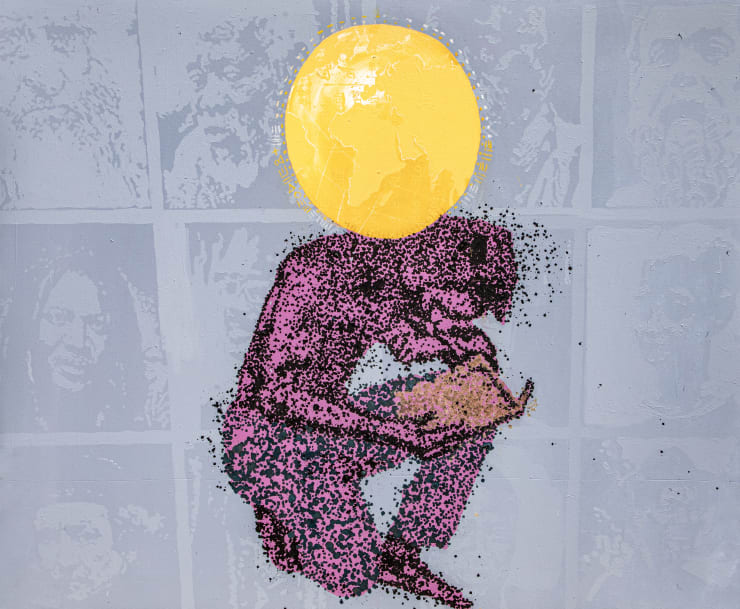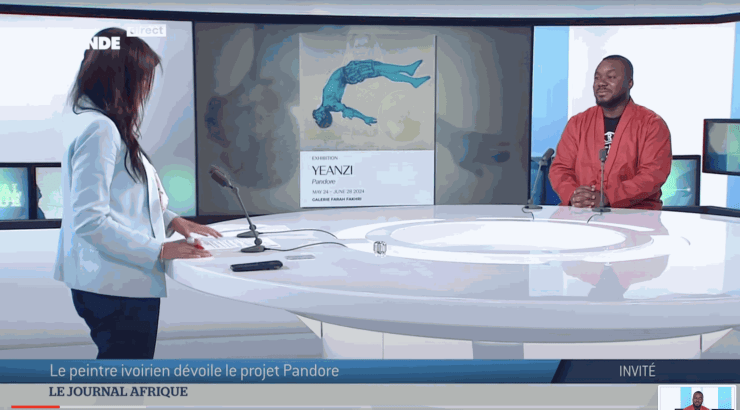Yeanzi | Pandore
Yeanzi’s project – Pandore – invites the viewer to reflect critically on the myth of Pandora's bow. This invocation stems from his enduring passion for myths and their boundless capacity to inspire human thought and societal evolution.
In Greek mythology, when Zeus, the king of the Olympian gods, breathed life into the earth, humans were its sole inhabitants. Prometheus, their protector and a titan who had fallen out of favour with the gods for stealing fire to benefit humanity, eventually became a fierce opponent of Olympus.
Falling under the wrath of the gods, Prometheus was condemned to a dreadful punishment, chained to the Caucasus, constantly living in fear of sanctions that could be unleashed upon humanity – punishments he could neither predict nor imagine.
Prometheus had a brother, Epimetheus. To him, Prometheus had made one critical request: to refuse any gifts or favours from Olympus and its cunning gods, he knew too well. However, Epimetheus, known for his lack of prudence, became the recipient of Zeus's most extraordinary creation – a gift designed to captivate the hearts of men. This was the very first human woman, Pandora, crafted by the skilled Hephaestus and brought to life by Athena herself.
Graceful yet capricious, Pandora was endowed with such captivating beauty and charm that even the gods themselves admired her. Entranced by her allure, Epimetheus could not refuse this exceptional offering. Enchanted by a newfound love and proud to possess the object of every man's desire, he succumbed to Pandora’s charms, forgetting entirely the promise he had made to his brother. To him, nothing else mattered but the burning love he felt for Zeus's precious gift.
Pandora did not arrive on Earth empty-handed. Before sending her to the world of men, the gods entrusted her with a mysterious box, the content of which was hidden from her. She was instructed to guard it carefully and never open it.
Though Pandora relished the perfect love she shared with her husband, her thoughts were often consumed by the box and its secret content. Her curiosity grew stronger each day, despite the god's prohibition. Each passing day, her gaze lingered on the box, feeding her temptation. Eventually, unable to resist any longer, she placed her hands on the lid and opened it.
She had opened Pandora’s box.
The moment the lid was lifted, all the evils within escaped—war, disease, ageing, and every imaginable affliction poured out to plague humanity. Though Pandora rushed to close the box, it was too late; the evils had already been unleashed.
Yet, one remained at the bottom of the box, too fragile and timid to emerge immediately. This last inhabitant was Hope. It is seen, paradoxically, as both a burden and a blessing. This torment fuels humanity’s ability to strive for change, mitigate chaos, and resist surrender, while simultaneously representing an unattainable ideal. Hope remains, in the human spirit, a sentiment that opens infinite possibilities. Rather than succumbing to despair, it leads to resilience, inspiring humans to defy adversity and seek purpose in their condition. While the myth takes a pessimistic tone, Yeanzi’s narrative offers a counterpoint.
Is this not the leap from mythology to reality?
Yeanzi’s new project invites us to reflect critically on this. His invocation of Pandora’s box stems from his enduring passion for myths and their boundless capacity to inspire human thought and societal evolution. By summoning Hope, Yeanzi underscores it as humanity’s ultimate resource – a foundation for salvation, essential to building not only individual fulfilment but also the collective progress of society. This society, for Yeanzi, is unique, defined by its culture and specificities.
“There is a cultural response to every societal question or problem,” he asserts, a conviction that shapes his artistic approach. Naturally, he focuses on his homeland, Côte d'Ivoire.
In his latest body of work, Yeanzi crafts a narrative semiology. His figures carry the world, symbolised by a luminous globe, bearing the weight of its balance on their shoulders or heads. Yet they are not crushed by its burdens. Instead, their majestic postures suggest strength and resilience, embodying humanity's capacity to endure and support the complexities of existence.
The centrepiece of this narrative showcases cardinal figures whom Yeanzi regards as references in the quest for hope – figures such as Imhotep, Leonardo da Vinci, and Cheikh Anta Diop. These icons share a symbolic garden of memory with Jems Kokobi and Alpha Blondy. At the heart of the composition stands the protagonist, the novice, whose gaze is fixed on the book of universal knowledge as he contemplates and proudly carries the world.
After years of international recognition, including his participation in the 59th Venice Biennale in Côte d’Ivoire’s pavilion, Yeanzi returns to exhibit in Abidjan. This project is an invitation to embrace hope. Though Pandora’s box may have already been opened in society, who better than Yeanzi to rekindle the spirit of resilience, singing to our collective consciousness an anthem that defines the very essence of our shared humanity?
Hail to the land of hope.
Sess Essoh




